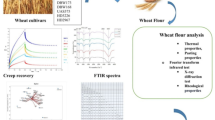Abstract
The blended dough made from raw wheat flour and wheat flour steamed for 15 min at a ratio of 1 : 1, along with minor ingredients (salt, oil) showed reduced farinograph water absorption capacity. The stability of the blended dough with oil was reduced while the mixing tolerance index increased. The inclusion of salt in the blend increased the resistance to extension and also the area under the curve. The hardness and cohesiveness measured by means of texture profile analysis decreased with the inclusion of oil in the blend, while increasing with the addition of salt. The Rapid Visco Analyser used to measure pasting characteristics showed a peak viscosity which increased for the blend with salt, but decreased for that with oil. Similarly, the hot paste viscosity, cold paste viscosity and area under the curve increased for the blend with salt, but decreased for the blend with oil.
Similar content being viewed by others
Author information
Authors and Affiliations
Additional information
Received: 5 February 1999 / Revised version: 21 April 1999
Rights and permissions
About this article
Cite this article
Prakash, M., Ravi, R. & Rao, P. Effect of blending of raw and steamed wheat flour on the rheological characteristics of dough. Eur Food Res Technol 210, 119–122 (1999). https://doi.org/10.1007/s002170050546
Issue Date:
DOI: https://doi.org/10.1007/s002170050546




